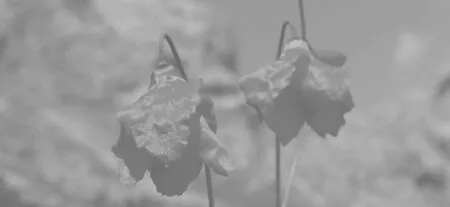“中国”威尔荪
2023-03-20涂杰
译/涂杰
One of the greatest plant-hunters of the early twentieth century, Ernest Henry ‘Chinese’ Wilson was born in 1876 and began his horticultural1horticultural 园艺学的。career as an apprentice at a local nursery before going on to study at Birmingham Botanical Gardens.In 1899 he was working at Kew when he was chosen to go on a plant-hunting expedition to China for Veitch’s nursery.
欧内斯特·亨利·“中国”威尔荪生于1876 年,是20 世纪初最伟大的植物猎人之一。他起初在当地苗圃当学徒,并从此开启园艺生涯,后又进入伯明翰植物园求学深造。1899 年,维奇苗圃选派当时供职于邱园(英国皇家植物园)的威尔荪去中国为苗圃采集植物。
2威尔荪首探中国的目的是寻得珙桐标本。珙桐又名“手帕树”,乃极为罕见的传奇之树,于1866 年由谭微道发现。此后,韩尔礼再次发现珙桐,但仅在一地发现独树一棵。又过了12 年,威尔荪才接到前往中国的任务。当时,哈利·维奇雇用了一批植物猎人,他劝告威尔荪一心寻找珙桐,莫要费财耗时遍地广集,因为他认为中国所有值得采集的植物可能都已引入英国。然而,威尔荪之后证明了他大错特错。
2The aim of this first expedition was to find specimens of Davidia involucrata, the Handkerchief Tree, an almost legendary rarity discovered in 1866 by Père David Armand2谭微道(佩尔·达维德·阿尔芒,1826—1900),法国动物学家、植物学家、博物学家、天主教遣使会会士。他是最早到中国考察动植物物种的欧洲人之一,也是最早研究中国物种地理分布的学者之一。依靠深厚的博物学背景,并以传教为依托,谭微道多次到中国进行科学考察,采集了大量的动植物标本与活体。他是最早发现并描述大熊猫、珙桐、金丝猴、麋鹿等物种的西方人。在中法两国,谭微道均是19 世纪博物学史以及生物学史上的重要人物。.A lone tree in a single location had been seen twelve years previously by Augustine Henry3韩尔礼(奥古斯丁·亨利,1857—1930),爱尔兰植物学家。他是现代植物学史上一位贡献极大的植物采集学家,也是迄今为止在中国土地上采集标本数量最多的外籍人士。.Harry Veitch, employing a number of plant-hunters at the time, advised Wilson to stick to the one thing he was searching for and not waste time and money wandering about as probably every worthwhile plant in China had already been introduced.Wilson was to prove him spectacularly wrong.
3为了找到珙桐,威尔荪的首要目标是拜访韩尔礼,而彼时韩尔礼正驻扎于云南的一个偏远小镇。于是,威尔荪遇水则乘船,着陆则骑骡,一路历经艰难险阻。见到了韩尔礼并与之商讨过后,威尔荪带着一张手绘地图再次上路,地图上面的十字记号标记着韩尔礼在其长达半年的考察之旅中发现的那棵珙桐的位置。经历了一段威尔荪委婉描述为“刺激”的旅程,他终于抵达了之前发现珙桐的地方,却发现当地人为了给新房腾地,不久前刚将珙桐砍伐。然而,威尔荪并未气馁,经过不懈努力,终于在湖北找到了一片正值花期的珙桐。同月,威尔荪还发现了“威尔荪中国醋栗”(现在称为猕猴桃)——这一发现当时并不引人注意,现在则广为人知。威尔荪驻扎在长江沿岸的宜昌镇,此后两年都在实地考察、采集种子。他采集了305 种植物的种子、满满35 个沃德箱的植株,以及大量的干制腊叶标本,总共可代表900 多个植物物种。
3Wilson’s first objective was to reach Henry, then stationed in a remote town in Yunnan.The journey, by river and mule,was arduous and dangerous.Having met and consulted with Henry, Wilson set out armed with a sketch map marked with a cross representing the single tree Henry had found in the course of a sixmonth trip.Wilson eventually reached the location of the previous sighting after a journey he described euphemistically as ‘exciting’, only to find that the tree had recently been felled to make way for a new house.Undaunted, he eventually managed to locate a grove of flowering trees in Hubei.In the same month,he made a discovery less celebrated but now probably better known—‘Wilson’s Chinese Gooseberry’, now known as the kiwi fruit.Making his base at the town of Yichang on the Yangtze River, he spent the next two years exploring and collecting seeds.He collected seeds of 305 different species and 35 Wardian cases4Wardian case 沃德箱,一种用于存放蕨类及类似植物的玻璃容器,由住在伦敦郊外的外科医生纳撒尼尔·巴格肖·沃德(Nathaniel Bagshaw Ward)发明。沃德箱问世后,植物经长途运输后的存活率大大提升,因此沃德箱成为植物猎人的必备品。full of plant material, as well as dried herbarium specimens, representing over 900 species in total.
4Wilson’s second trip to China in 1903 was in search of the yellow poppy Meconopsis integrifolia.He was able to hire many of the men who had worked with him on his previous expedition.In contrast to some other Western planthunters of the time, Wilson respected and got on well with the Chinese people he met and employed.Travelling from Sichuan into Tibet, he secured seeds of both Meconopsis integrifolia and the red Meconopsis punicea.He suffered from altitude sickness and other illnesses, and had lost almost three stone by the time he reached Songpan in Sichuan.He returned to England in 1905,with the seeds of over 500 species and 2,400 herbarium specimens, including Lilium regale, the species he was most proud of introducing in his remarkable career.
41903 年,威尔荪二探中国,此行的目的是寻找黄色的罂粟属植物——全缘叶绿绒蒿。威尔荪得以雇到上次中国之行为其做事的许多人员。不同于当时其他一些西方植物猎人,无论是与他相逢,还是受他雇用的中国人,威尔荪都予以尊重,并与他们相处融洽。威尔荪从四川进入西藏,沿途采集了全缘叶绿绒蒿和红花绿绒蒿的种子。途中,威尔荪深受高原病等疾病之苦,到达四川松潘时瘦了近3 英石(约19 千克)。1905 年,威尔荪返回英国,带回了500 多种植物的种子和2400 多份腊叶标本,其中包括他引进的岷江百合——这是他杰出职业生涯中最引以为傲的成就。

5威尔荪三探中国是受哈佛大学阿诺德树木园之托。园方主要对木本植物感兴趣,但本次行程的部分资金由赞助人提供,因此威尔荪还要为他们采集兰花和百合等植物。阿诺德树木园还要求威尔荪沿途尽量多拍照记录。威尔荪用干板相机拍出的照片在当时称得上十分出色,目前这些照片由阿诺德树木园的档案馆收藏保管。
5Wilson’s third expedition to China was undertaken on behalf of the Arnold Arboretum of Harvard University.Their interest was primarily in woody plants,but the expedition was partially funded by subscribers, for whom Wilson was to look for orchids and lilies amongst other things.The Arnold Arboretum also asked Wilson to photograph as much as he could.His photographs, taken on a plate camera5干板相机,使用玻璃干板相片的相机,拍一次就得换一次相片。, were quite remarkable for the time and are now in the Arboretum’s archive.
6Surviving famine and a bad bout6bout(疾病或不愉快情绪的)发作。of malaria, Wilson shipped huge amounts of plant material to the United States in 1908, including thousands of lily bulbs.Unfortunately, almost all of the bulbs rotted in transit.
6这次旅行,威尔荪经历了饥荒,还深受疟疾之苦,所幸他大难不死,在1908 年将大批植株运往美国,其中包括数千株百合球茎。但遗憾的是,百合球茎在运输途中腐烂殆尽。
7威尔荪四探中国主要是为了采集更多的百合球茎。这次威尔荪是勉为其难,不料这趟收官之旅让他付出了惨重的代价。威尔荪总是备着轿辇出行却不常乘坐。轿辇只是用作尊贵地位的象征,方便他通行顺畅。然而有一次,威尔荪正坐在轿辇上,沿着狭窄的山路前行,队伍突遭雪崩袭击。威尔荪在千钧一发之际挣脱出来,没有随轿辇一同坠入崖下,却被落石砸中,腿上有两处骨折。幸好无人殒命,只有一名脚夫受伤。就在随从用相机三脚架临时当作夹板将他骨折的腿固定时,一队骡子迎面赶来。威尔荪挪不开,而骡队既无法通过这条狭窄山路,又恐再有落石而不想原地逗留,因此威尔荪索性横躺在山路中间,任凭骡子从他身上跨过。此后3 天,他们一路急行,折返成都,就近求医。骨折诱发感染,害他险些截肢。经过3 个月的治疗,威尔荪伤势好转,得以返回美国,但他腿上却永远留下了病根,只能终生跛行(他戏称之为“百合跛”)。
7It was to collect more lily bulbs in particular that Wilson was reluctantly persuaded to make one last expedition to China, with serious consequences.He always travelled with a sedan chair,though he rarely used it, as it was a kind of badge of respectability that allowed the traveller to pass freely.For once he was being carried in the chair, on a narrow mountain road, when the expedition was hit by an avalanche.Wilson managed to get out of the chair just before it was carried over the edge, but was hit by falling rock and broke his leg in two places.Fortunately only one of the porters was injured and no one was killed.While the leg was being immobilised with splints improvised from the camera tripod, a mule train came up.Wilson could not be moved and the mule train could neither pass on the narrow track, nor wait in case of further rockfalls, so he lay across the road and the mules stepped over him.After that it was a three days’ forced march back to the nearest medical attention in Chengdu.Infection set in7set in(不好的事情)开始;到来。and he came close to losing his leg.After three months he was well enough for the journey back to the States, but the leg never healed properly and he walked with what he called his ‘lily limp’ for the rest of his life.
8This was the end of his travels in China.Between 1911 and 1915, he collected specimens in Japan for the Arboretum, including 63 named flowering Cherry forms, and in 1917 he made an expedition to Korea.His wife and daughter joined him on these trips.Wilson named Rosa helenae and the bamboo Fargesia murielae after them.
9Ironically, given the dangers and privations he had survived on his collecting trips, Wilson died in a car accident in the States in 1930, three years after becoming Keeper of the Arnold Arboretum.
10In total, Wilson introduced about 2,000 Asian plant species to the West.Sixty species of Chinese plants are named after him.■
8这便是他中国之旅的结局。1911 年至1915 年间,威尔荪前往日本为阿诺德树木园采集标本,其中包括63 个已命名的樱花树品种。1917 年,他前往朝鲜半岛展开考察。这几次旅程中,他的妻女也与他同行。后来,他用妻女的名字分别命名了卵果蔷薇和神农箭竹。
9讽刺的是,威尔荪在植物采集之旅中历尽艰险困苦而生还,最终却于1930 年在美国死于车祸,当时他接管阿诺德树木园仅3 年。
10威尔荪总共将约2000 种亚洲植物引入西方,同时,有60 种中国植物以他的名字命名。 □
